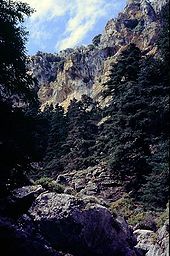Sierra de las Nieves
| Sierra de las Nieves | ||
|---|---|---|
| Highest peak | Torrecilla ( 1919 msnm ) | |
| location | Málaga Province , Spain | |
| part of | Betic Cordillera | |
|
|
||
| Coordinates | 36 ° 41 ′ N , 5 ° 0 ′ W | |
| rock | lime | |
The Sierra de las Nieves is a mountain range in the southwest of Spain ( province of Málaga , Andalusia ). It belongs to the Ronda Mountains and, like this, to the Betic Cordillera . Imposing limestone mountains , deep gorges and abysses shape the image of this mountain range, which reaches a height of 1919 m (Torrecilla) - high enough that snow was collected here earlier (the Spanish name stands for snow mountains ).

With a total of 3000 hectares, the Sierra de las Nieves has the largest proportion of southern Spanish hedgehog fir forests and one of the largest stocks of ibex .
The core area of the Sierra de las Nieves has been protected as a nature park since 1989 (which was enlarged again in 1999 ), and since 1995 the Sierra de las Nieves has been declared a biosphere reserve by UNESCO .
The heart of the natural park is the Sierra de la Nieve, which has some of the most famous peaks, e. B. the Enamorados (1775 m) and on their northern slopes some beautiful hedgehog fir forests.
Between it and the places El Burgo and Yunquera lies the Sierra del Pinar, the main growing area of the hedgehog forests. In the Sierra de Tolox to the south lies the highest peak, the Torrecilla (1919 m). In these mountains there are beautiful stocks of Portuguese oak and one of the deepest caves in the world.
The Río Guadalevín , which cut the famous Ronda Gorge into the rock, has its source in the Sierra de las Nieves . In the northeast of the area and through the town of the same name runs the Río El Burgo , in the east there is the Río Alfaguara , which flows through Tolox and flows into the Río Grande , which originates at Yunquera and which itself flows into the Guadalhorce . In the south of the nature park runs the Río Verde , which rises on the southern slope of the Torrecilla and flows into a reservoir behind Istán , which supplies the Costa del Sol with water.
climate
The Sierra de las Nieves lies between the Atlantic and the Mediterranean . The climate is basically a typical Mediterranean climate - hot, dry summer, precipitation in autumn, in mild winters and in spring - but especially in summer the higher location also absorbs damp winds from the Atlantic, which leads to the formation of fog and cloud in summer lead to rain (mostly with thunderstorms). This higher humidity is ultimately the reason for the existence of hedgehog forests and Portuguese oak.
Flora and fauna
The vegetation of the Sierra de las Nieves is particularly remarkable for its hedgehog forests. They are a relic of these coniferous forests, which were widespread in the Tertiary and which, due to the humid climate at higher elevations on northern slopes - especially in the Sierra del Pinar and the Sierra de la Nieve - were able to maintain themselves and which still form extensive forests today. The best-known animal species in the nature park are the ibex , of which one of the largest Spanish populations can be found here. In addition, especially the birds of prey are striking, of which here golden eagles , short-toed eagle , booted eagle and Bonelli's eagle happen occasionally are griffon vulture watching. There are also eagle owls , tree and peregrine falcons as well as hawk and sparrowhawk in the hedgehog forests .
Web links
- Sierra de las Nieves Information on nature and landscape, hiking and tourism in the Sierra de las Nieves
- Official website of the nature park administration (Spanish speaking)


